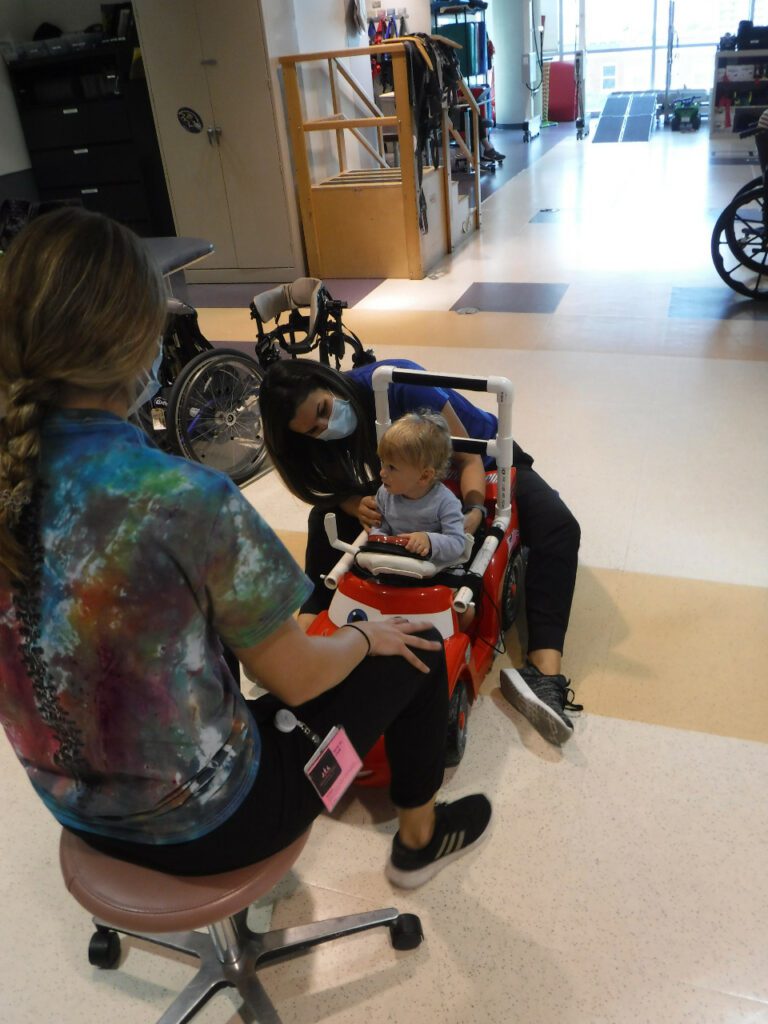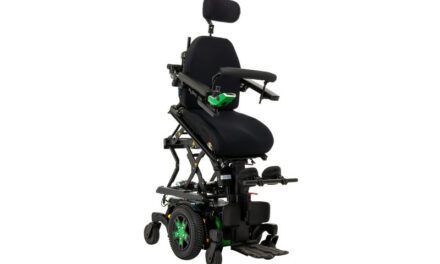CAPTION: A toy with a simplified switch and a seat modified to provide more support becomes a vehicle for self-mobility and engagement.
Adapted equipment such as modified ride-on toy cars allow disabled children to experience engagement, exploration, play, and self-activated mobility.
by Brooke Kelley, MS, OTR/L, and Courtney Heavner, PTA
Four-year-old Alex had always been an active and healthy child. But one day he started having flu-like symptoms, and within 48 hours, Alex’s world was turned upside down. He experienced sudden paralysis and difficulty breathing requiring mechanical ventilation. Alex was diagnosed with a rare disease called acute flaccid myelitis (AFM) that attacks the spinal cord, resulting in muscle weakness and affecting the ability to breathe.
Similarly, 9-year-old Emma loved dancing and painting. She was riding in a car with her mother one afternoon when they were suddenly T-boned by another vehicle running a red light. Emma experienced whiplash that caused damage to the spinal cord, resulting in quadriplegia.
Prior to their hospitalizations, both Alex and Emma’s leisure engagement revolved around physical activity. Leisure isn’t a word often equated with children’s activities. More often, the picture of leisure is a retired, elderly man swinging a golf club or a woman gardening. Kids do participate in leisure, but we think of it as simply playing. Leisure activities are any activities a child willingly and freely chooses to participate in for enjoyment, and are enjoyed during a child’s free time, not influenced by adults.
Now, Alex struggles to sit up on his own, and has difficulty grasping a baseball bat or kicking his leg. Emma needs a power wheelchair for mobility and can’t stand or move her arms and legs the way she used to. This type of situation creates a unique challenge and opportunity for rehab therapists, who are pursuing therapeutic goals, but also want to engage children in their main occupation of play and leisure.
At Kennedy Krieger Institute’s International Center for Spinal Cord Injury (ICSCI), physical and occupational therapists work with kids like Alex and Emma who have lost their ability to engage in leisure the way they used to before their disease, injury, or disorder. Because play is a child’s primary job and essential to their growth and development, ICSCI seeks fun and innovative ways to promote participation in leisure engagement and self-initiated mobility. The notion of “participation” has been brought to the forefront of rehabilitation by the World Health Organization’s classification of health and functioning.1
Participation is involvement in everyday activities and roles.1 Children participate in leisure activities that result in social growth and development. It is essential for children to participate in leisure in order to influence social skill development, choice-making, autonomy, overall mood, and for coping when dealing with stress.1 ICSCI particularly focuses on leisure participation and independent mobility through Activity Based Restorative Therapy (ABRT). ABRT utilizes active and purposeful tasks and repeated movements to stimulate the central nervous system that promotes the recovery of lost function.
Facility-Based Support
ICSCI uses a variety of adapted equipment to engage children in leisure. This includes modified ride-on toys to promote engagement, exploration, play, and self-activated mobility following the principles of the Go Baby Go program.
Go Baby Go was a project created out of the University of Delaware by founder Cole Galloway. The mission of Go Baby Go is to increase mobility and the quality of life for children around the world who experience various illnesses, injuries, or disabilities. The overall goal is to modify ride-on toys to allow children to explore their world via independent mobility. Go Baby Go programs have been adopted across the country by various service, professional, and student groups to enhance the play and leisure experience for children.
Utilizing ride-on toys provides children with a more normalized engagement in play. All of a sudden, children who have had a loss of mobility and strength are able to interact with their peers in their community, at home, and at large through modification and adaptation. Our main goal is to provide children with a sense of belonging. Fabrication of individualized modifications allows children to access a toy adapted for their own being.
Not only are vehicles modified for clinical use, ICSCI also hosts two annual workshops where therapists make individual modifications to patients’ personal “vehicles” in order to provide carryover and access in the home and community environment. Parents and children select and purchase a ride-on toy vehicle of their choice to meet personal preferences. From there, a team of physical and occupational therapists assesses the child in the vehicle and makes customized accommodations to fit the specific child’s needs and desires. Utilizing customization allows for access to repeat engagement and optimizes benefits of use. In addition, children are able to engage with peers in their community in a more normalized sense.
Modification Technologies
ICSCI utilizes various technologies to equip patients to pursue leisure engagement. Modified ride-on toys are a fun and exciting tool that children love. The ride-on toy’s acceleration pedal is re-wired (a basic skill requiring minimal tools and easy-to-follow instructions) and replaced with a single-switch buddy button. This reduces the demand of the task to initiate the movement of the car. Once a child has grasped the concept of initiating mobility and has begun to explore, steering training and multiple switches can be introduced later.
Oftentimes, children with mobility impairments experience low tone, poor trunk control, and an inability to efficiently use their extremities. Thus, the seats of the vehicles are modified in such a way that the child can be positioned safely upright and supported in an optimal fashion. This is done with objects such as PVC pipes, pool noodles, kick boards, gel pads, and foam.
ICSCI’s current modified ride-on toy fleet is impressive and diverse. A ride-on ATV has been modified with a simple pressure switch that will cause the vehicle to move if the child performs a sit to stand, releasing the pressure on the seat. This forces the child to use his/her lower extremity muscle and activates shoulder stabilizers as they grip the handles. Not only does this toy foster engagement in play, it provides a fun way for a child to strengthen and train his or her lower extremities. Additionally, this purposeful activity engages the child’s ability to learn cause and effect. If they stand, the vehicle moves forward; if they sit, the vehicle stops.
Through the vast array of vehicles we house, we are able to target ride-on mobility, engagement in play, and therapeutic treatment for children of various ages, sizes, and diagnoses to provide an inclusive environment. In addition to the fleet of vehicles owned, therapists are able to constantly evolve and improve modifications with our in-house supply of materials in order to ensure individual fit and access for all.
Although the benefits of the ride-on toys are vast, there are a few considerations that therapists should consider before using them with a child. The first would be the amount of head control the patient has. If there is not a second or third staff member available to provide head support, it is difficult to modify a car to have head/neck support, so oftentimes a second staff member needs to be behind the car holding the patient’s head. Another consideration would be the amount of movement the child has to access the buddy button. There are a variety of switches that can be placed in creative ways, so the child can attempt to initiate the movement of the car via the button.

More Equipment for Mobility
In addition to ride-on cars, there are other pieces of equipment including mobile standers, gait trainers, and adapted cycles that allow children better access to engage in leisure activities. Mobile standers allow children to self-initiate mobility for where they want to go, encouraging them to explore their environment without the influence of adults, freeing them to participate in leisure on their own terms. They can also use these devices to participate in activities such as video games or virtual reality, providing a safe, therapeutic position while having fun.
Gait trainers and walkers allow a child to be upright while partially weight bearing through their legs and performing a reciprocal pattern for improving his or her ambulation/walking skills. They can participate in a scavenger hunt or a modified version of hopscotch.
Adapted bicycles and tricycles are a definite favorite at ICSCI. There are a variety of models of adapted cycles, and a specific model can be chosen specific to the child’s current function and ability. There are options for a child to propel a bike with their legs or arms. A hand-propelled tricycle, for instance, allows for upper extremity propulsion, but still provides the sensory input of reciprocal leg movement as the lower pedals revolve as the arm handles are cycled. There are also cycle seats that provide extensive trunk and even head support. Adapted cycles allow children to engage in leisure in the community at a park or around the neighborhood, and little do they realize that they are participating in strength training and cardiorespiratory exercise at the same time. As far as they’re concerned, they are simply riding a bike.
Social Support
Children with traumatic and non-traumatic paralysis, such as a spinal cord injury, have their mobility patterns interrupted suddenly, often resulting in decreased engagement in age-appropriate leisure tasks. The inability to initiate mobility or inefficiently move about decreases a child’s opportunity to explore their environment, participate in leisure activities, and gain foundational developmental skills necessary for flourishing. Without these skills, they are at risk for experiencing cognitive, social, and emotional issues. Studies have shown that even children with diverse needs and mobility impairments can benefit from self-activated mobility.
It is common for therapists and caregivers to approach therapy and leisure engagement as separate endeavors. Therapists play a vital role in weaving therapy and enjoyment together and modeling this skill for caregivers to replicate in the home setting. Therapists often lead the strategy for mobility and leisure engagement, exposing patients to new methods of mobility and fun that caregivers might not know are available to their child. Therapists have access to technology and various equipment they can trial in a clinical setting to see what works optimally for each child. Therapists also have knowledge related to community resources and funding options that can be shared with caregivers such as loan closets and grant programs.
The role of caregivers is equally as important. Caregivers must be on board with the various strategies the therapist wants to implement. Additionally, parents can be hands-on with transfers and transportation of equipment. It’s important that they understand the use of the equipment and know how to safely use it with their child, so that carryover at home is seamless in order to maximize the benefits that pieces of equipment can afford the child.
ICSCI believes in the benefits of promoting creative and innovative ways for children with mobility impairments to return to engaging in leisure activities as well as self-activation of mobility through the use of modified ride-on toys and other equipment that allows for self-engaged mobility. Resources are widely available online and through University of Delaware’s Go Baby Go website that provide self-guided instructions for how to modify specific ride-on toys at home.
Now, Alex can drive a modified ride-on toy and enjoy interacting with his younger sibling outside again, experiencing the rush of mobility and speed. Emma can use a mobile stander and be involved in her ballet class in a modified and independent way. Therapists have the privilege of facilitating an environment where leisure is once again accessible to these children, so they can focus on what’s most important to them: play. RM
Brooke Kelley, MS, OTR/L, is a level II occupational therapist at Kennedy Krieger Institute’s International Center for Spinal Cord Injury (ICSCI).
Courtney Heavner, PTA, is a level II physical therapist assistant at Kennedy Krieger Institute’s ICSCI. For more information, contact [email protected].
References
- Majnemer A. Promoting participation in leisure activities: expanding role for pediatric therapists. Phys Occup Ther Pediatr. 2009;29(1):1-5. doi: 10.1080/01942630802625163





